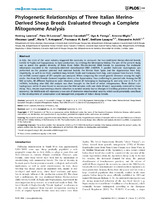Mostrar el registro sencillo del ítem
Phylogenetic Relationships of Three Italian Merino-Derived Sheep Breeds Evaluated through a Complete Mitogenome Analysis
| dc.contributor.author | Lancioni, Horivag | |
| dc.contributor.author | Di Lorenzo, Piera | |
| dc.contributor.author | Ceccobelli, Simone | |
| dc.contributor.author | Perego, Ugo A. | |
| dc.contributor.author | Miglio, Arianna | |
| dc.contributor.author | Landi, Vincenzo | |
| dc.contributor.author | Antognoni, Maria T. | |
| dc.contributor.author | Sarti, Francesca M. | |
| dc.contributor.author | Lasagna, Emiliano | |
| dc.contributor.author | Achilli, Alessandro | |
| dc.date.accessioned | 2020-04-02T12:44:18Z | |
| dc.date.available | 2020-04-02T12:44:18Z | |
| dc.date.issued | 2013 | |
| dc.identifier.uri | http://hdl.handle.net/10396/19865 | |
| dc.description.abstract | In Italy, the crisis of the wool industry triggered the necessity to reconvert the two traditional Merino-derived breeds, Gentile di Puglia and Sopravissana, to meat production, by creating the Merinizzata Italiana. The aim of the present study was to assess the genetic diversity of these three Italian Merino-derived (IMd) breeds by examining the molecular information encoded in the maternally-inherited mitochondrial DNA (mtDNA). A parallel molecular investigation was performed on the putative paternal and maternal breeds, the Merino from Spain and the Appenninica from Italy, respectively, as well as on three unrelated dairy breeds (Sarda and Comisana from Italy, and Lacaune from France). Firstly, the mtDNA control region of 291 samples was analyzed. When comparing the overall genetic distances among the eight stocks, the three IMd breeds clustered together close to the Appenninica, thus confirming its parental role. Among the 90 IMd samples, 82 different haplotypes were observed, almost all belonging to haplogroup B, and only one to A. For 23 mtDNAs, including nine IMd, the analysis was then brought to the level of entire mitogenomes. Three distinct sub-haplogroups within B were found to encompass the IMd samples, with one clade (B1a2a1) apparently restricted to those sheep. Thus, despite experiencing a drastic reduction in number (mainly due to changes in breeding practices driven by the economy), the IMd breeds still represent a reservoir of distinctive mitochondrial variants, which could potentially contribute to the development of conservation and management programs of Italian sheep breeds. | es_ES |
| dc.format.mimetype | application/pdf | es_ES |
| dc.language.iso | eng | es_ES |
| dc.publisher | Public Library of Science | es_ES |
| dc.rights | https://creativecommons.org/licenses/by-nc-nd/4.0/ | es_ES |
| dc.source | PLOS ONE 8(9): e73712 (2013) | es_ES |
| dc.subject | Mitochondrial DNA | es_ES |
| dc.subject | Sheeps | es_ES |
| dc.subject | Haplotypes | es_ES |
| dc.subject | Mitochondrias | es_ES |
| dc.subject | Species diversity | es_ES |
| dc.title | Phylogenetic Relationships of Three Italian Merino-Derived Sheep Breeds Evaluated through a Complete Mitogenome Analysis | es_ES |
| dc.type | info:eu-repo/semantics/article | es_ES |
| dc.relation.publisherversion | https://doi.org/10.1371/journal.pone.0073712 | es_ES |
| dc.rights.accessRights | info:eu-repo/semantics/openAccess | es_ES |

